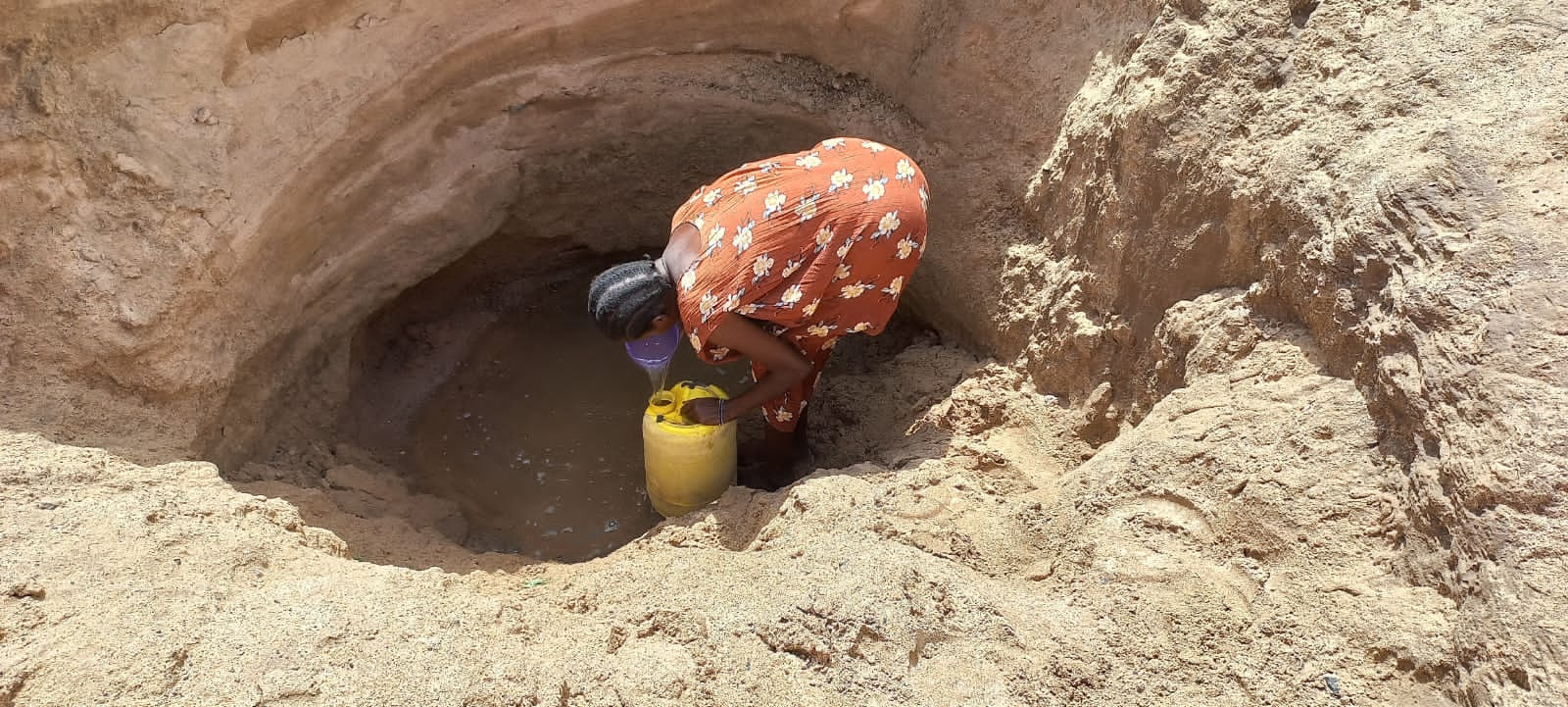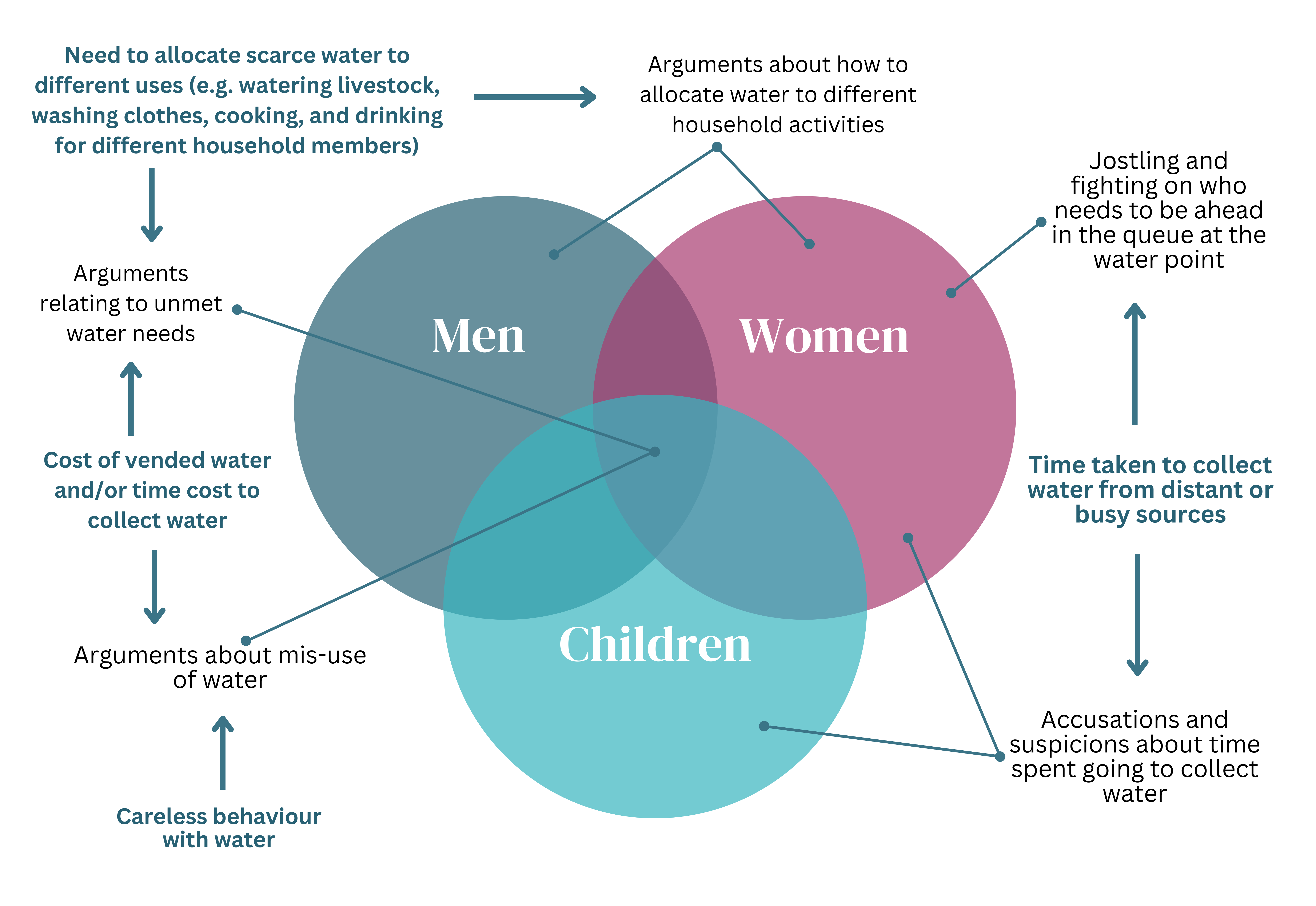A blog by Prof. Salome Bukachi and Mercy Mbithe from the University of Nairobi
Water, a life-giving resource, can paradoxically also be a source of conflict. Researchers and policy-makers regularly talk about the nature and status of water related conflicts, the risks associated with conflict due to water scarcity, and tools to reduce such conflicts. Conflicts are understood to occur at different scales – from regional disputes at a village level to disputes between national regions, or across borders at the international level. They also occur within households. However, research into conflict around water at this level is rare, and the impacts of intra-household water conflicts may be masked when policies and interventions are made based on an understanding of conflicts at larger scales. We conducted qualitative research, as part of the REACH WISER research, to explore the nature of water–related conflict and highlight the conflicts around water at the household level in Turkana County, Kenya. Turkana County is one of Kenya’s ASAL counties (Arid and Semi-Arid Lands), recently affected by multi-year droughts exacerbated by climate change. Through this study, we seek to amplify the voices of the community – as the saying goes: “The wearer of the shoe is the one who knows where the shoe pinches most”.

Photo: A woman fetching water in a dug-out dry Kawalase river bed well during the dry season (Image credit – Mercy Mbithe)
The study was carried out in different study sites in urban, peri-urban and rural areas. The households in these communities utilized several sources of water to enable them to address their water needs. These included, rivers, boreholes, shallow wells, water from water tracking tanks, earth pans, and the county government piped water. Conflicts over water were reported more often in peri-urban and rural study sites where households fetch water from limited water sources and must trek long distances or wait at the water wells for long durations especially during the dry season. The nature and causes of conflicts as reported by the household members we spoke to were hugely varied, affecting household members in different ways (Figure 1).

Figure 1: Reported causes are presented with arrows to the types of conflict caused. The lines into the Venn diagram illustrate whether women, men or children reported the type of conflict.
The following excerpts amplify the voices of the participants from various households and put in focus the context and the gendered nature of the conflicts experienced:
“Every day I or my children have to fetch water once or twice a day for my family 1 jerrican in the morning and evening. Access to water, sanitation and hygiene is a basic human right yet my family and my neigbours are struggling to access water. I spend an average of 2 hours per day to get water from my main source of water. Sometimes relief comes when we get water brought to my village by the water bowser. During prolonged drought, I sometimes take long at the water source even coming back late at night. My family and I sometimes fight over water due to several reasons”. Female participant
“There are conflicts because … when you come home late at night. [Husbands] will have bad thoughts because you are coming late and maybe think you are doing something unfaithful…going for long distances and queueing [for water takes time]…. the time taken to queue and maybe you are the last person to collect water and by the time [you] comes back [you]arrives at 10pm. you have to tell [your husband] where you have been…We also face sexual related violence such as rape when out early or late at the water sources”. – Female participant
“You did not bring any money and the water that is available is that from the well and it is very salty and there is fresh water that is sold there at the market and here you do not have money. The wife will ask what kind of a man are you that cannot even provide water on the table!” – Male participant
“A motorbike costs one hundred Kenyan shillings per trip and fifty Kenyan shillings for five twenty-liter jerricans the total amounting to one hundred and fifty shillings per trip. Buying water is another reason that can lead to conflict at the household level [if water is “misused”]”- Male participant
“There are people who misuse water. A person may want to shower three times a day, another one may want to give his friends to drink or may want to drink water as many times as they wish or when children misuse it, we will quarrel because for us just pouring a drop on the ground is so painful. …So, when the person who collected water complains, that brings conflicts. You know, a person who can feel pain concerning how the water is being used is that one person who collects water. Water issues can lead to fights in a household.” – Female participant
“Water brings conflicts among household members because it is not enough. For example, a husband may want to take a shower, yet the available water is not enough for cooking and drinking and he insists that he wants to shower, that way it may lead to conflict and fights.” – Female participant
The above quotes depict how men and women within the same household experience different issues relating to water scarcity and meeting water needs and how these have the potential of creating conflict in the households. It is important to note that this study was focusing on conflict, hence it did not reflect or collect examples of collaboration or positive conflict resolution within households, which may equally exist within households working to meet their water needs. That said, conflicts related at the household level have likely been exacerbated by climate variability and increased water demand, which are both important drivers of water scarcity in the area (Hirpa et al., 2018).
Conclusion:
Water-related conflicts do not only occur at higher levels but are also present in households. There is a need for further detailed studies at the household level to understand the magnitude of water-related conflict and the ways it affects people of all genders and ages in the household. Water scarcity related to climate change and increased water demand exacerbates water conflict due to the prolonged time needed to fetch water and the high cost of vended water challenging the ability of households to meet their water needs. Water-related conflicts at the household level mainly arise from financial and time pressures on household members involved in collecting water and during decision-making over the allocation of limited water to different uses.
The duty bearers in relation to water collection experience the stress of having to collect and allocate the limited water resource, hence the need for targeted interventions to improve water services. Development and expansion of climate resilient water infrastructure may reduce the cost and work burden associated with water collection, which fall especially on women and children, and thus help relieve water related conflicts at the household level.
